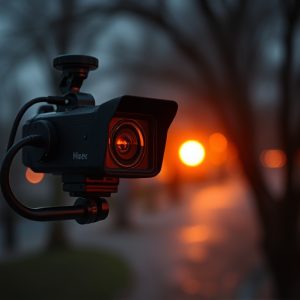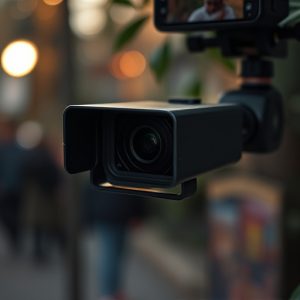Unveiling Hidden Cameras: Light Reflection for Indoor Security
Wireless Night Vision Security Cameras indoors have become a privacy concern, prompting the developm…….
Wireless Night Vision Security Cameras indoors have become a privacy concern, prompting the development of spy camera detection techniques like the Light Reflection Method. By manipulating light sources and observing unique reflection patterns, experts can identify hidden cameras disguised as everyday objects. This non-intrusive approach is crucial for high-risk environments where covert surveillance poses a significant threat. Strategically placing reflective surfaces allows for easy detection of these devices, offering enhanced indoor security and privacy protection against espionage or surveillance activities.
In today’s digital age, privacy concerns have escalated with the proliferation of wireless night vision security cameras indoors. This has led to the development of innovative spy camera detection techniques, such as the light reflection method. Understanding this technology involves recognizing how subtle changes in light reflections can expose hidden cameras. This article explores the light reflection technique for spy camera detection, its growing relevance in indoor security, and comprehensive post-detection strategies to fortify personal spaces from these covert threats.
- Understanding Spy Camera Detection: The Light Reflection Technique
- Wireless Night Vision Security Cameras: A Growing Concern
- Practical Implementation of Light Reflection for Spy Camera Detection
- Enhancing Indoor Security: Post-Detection and Prevention Strategies
Understanding Spy Camera Detection: The Light Reflection Technique
Understanding Spy Camera Detection: The Light Reflection Technique
Spy camera detection is a critical aspect of ensuring privacy and security, especially in indoor spaces equipped with wireless night vision security cameras. The light reflection technique is a sophisticated method employed to uncover covert surveillance devices. This approach leverages the reflective properties of light to reveal hidden cameras that might be disguised as everyday objects. By directing specific wavelengths of light onto walls, ceilings, or other surfaces within a room, any reflective surface associated with a spy camera will produce a unique pattern of reflection.
Through careful analysis of these reflections, experts can identify unusual patterns indicative of camera lenses or sensors. This non-intrusive technique allows for the proactive discovery of hidden surveillance equipment without disturbing potential evidence. It’s particularly effective in high-risk environments where the presence of such devices could compromise sensitive operations or personal privacy.
Wireless Night Vision Security Cameras: A Growing Concern
Wireless Night Vision Security Cameras have become increasingly prevalent in both residential and commercial settings, offering enhanced security and peace of mind for homeowners and business owners alike. However, this growing trend has also sparked a new concern: their potential to be used surreptitiously. These cameras, designed to operate wirelessly and provide clear images in low-light conditions, can be difficult to detect, especially when hidden indoors. The very features that make them attractive—wireless connectivity and night vision capabilities—also make them vulnerable to misuse by malicious actors who may attempt to install them without the knowledge or consent of the occupants.
This has led to a heightened awareness among individuals and organizations about the importance of spy camera detection techniques, particularly in enclosed spaces where light reflection can be manipulated. The reflection of light off hidden cameras can often reveal their presence, making it a critical tool for identifying and mitigating potential security risks associated with these wireless devices. As technology advances, so does the need to stay vigilant against such threats and employ innovative methods to counter them.
Practical Implementation of Light Reflection for Spy Camera Detection
The practical implementation of light reflection for spy camera detection involves a sophisticated yet accessible approach to enhancing indoor security. By utilizing wireless night vision security cameras, this method leverages the reflective properties of light to uncover hidden surveillance devices. The process typically starts with strategically placing reflective surfaces, such as highly polished metal or specialized mirrors, in areas where covert cameras might be installed. When light sources, like ambient lighting or specifically designed reflection triggers, bounce off these surfaces, any camera lenses present will reflect the light back, making them easily detectable by trained eyes or advanced security systems.
This technique is particularly effective for indoor spaces due to the controlled environment, allowing for precise adjustments to lighting and reflective angles. It offers a game-changer solution for privacy protection, empowering individuals and organizations to safeguard their spaces from hidden cameras used in espionage or surveillance. With proper execution, light reflection can become an inconspicuous yet powerful tool in the arsenal of wireless night vision security cameras, ensuring peace of mind and enhanced security against unwanted peepers.
Enhancing Indoor Security: Post-Detection and Prevention Strategies
After detecting a spy camera using light reflection techniques, enhancing indoor security involves a multi-faceted approach. One key strategy is to upgrade existing surveillance systems with wireless night vision security cameras indoors. These advanced cameras offer enhanced visibility in low-light conditions, making it easier to identify and monitor potential hidden devices. By integrating these cameras into your security network, you create an additional layer of protection against covert surveillance.
Additionally, implementing post-detection prevention strategies is vital. This includes regular maintenance and inspections of all indoor spaces to ensure no unauthorized cameras are present. Educational campaigns for residents or employees can also be effective, raising awareness about the risks and signs of spy cameras. Regular updates to detection techniques and staying informed about new technologies in camera detection will further strengthen indoor security measures.
The detection of covert spy cameras using light reflection techniques offers a promising solution to counter the growing concern of wireless night vision security cameras indoors. By understanding how light interacts with these hidden devices, we can enhance indoor security through practical implementation and effective post-detection strategies. This approach not only safeguards privacy but also underscores the importance of staying vigilant in today’s digital era, where technology can both empower and pose subtle yet significant threats.


